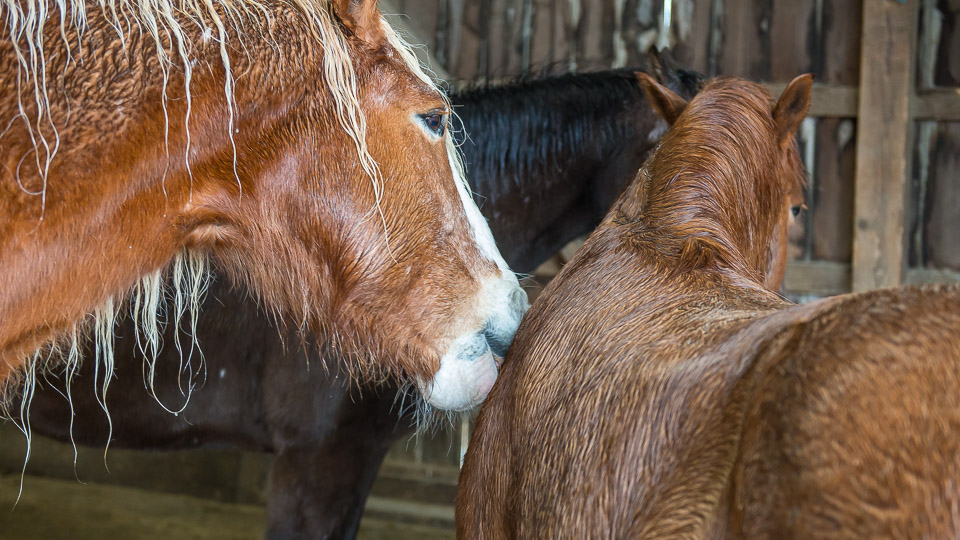
Horse Behavior – An Introduction
The subject of behavior is fascinating to me because we all usually are interacting with a captive horse. Their behavior has adapted to what they know from being handled by humans from their first moment on this earth. They have never been free. Yet deep in their minds are the instructions to survive as free animals. Conflicts arise when primal instincts are juxtaposed with current knowledge and beliefs of what they are experiencing.
For example, all horses should be afraid of humans as in the past they were hunted and eaten by other animals. Some were captured and tamed for riding and pulling our things around. It must be realized by all owners that the brain of the horse is very similar to ours. When we touch a hot stove as a child we remember and avoid touching hot stoves forever. When we are embraced by our mothers after a bad dream we remember that too. The good and the bad memories are kept in the neocortex and their associated emotions are connected with in the amygdala. This emotion area of the brain is directly connected to the motor cortex causing movement. When afraid, the horse will run. When afraid and no where to run, the horse will fight. This is their most basic survival behavior.
In between “normal” behavior and survival behavior lies the complexities of owning a horse. What drives them to pleasure (mutual grooming)? What drives them to chew the barn down? What makes them curl their upper lip? What is causing food aggression, bad riding behavior and shutting down? Surprisingly, the causes are simple and similar to our own thoughts. Unfortunately some of these behaviors may be impossible to correct if we continue to cause them. With some really aggressive and dangerous horses, euthanasia occurs. But I have found one thing that seems to really work. Let them know you are listening. Some just need to know you are listening.
Use the browser back button or menu to return to the index of topics.
Get Your Brain Right, Get Your Horse Right
“Cognitive Laziness” is how we interact with horses today. Through agenda driven medicine and marketing, I look at the collision of new and old.
Grazing Not Browsing -Decomplexicating Equine Nutrition Part 1 of 12
All equids graze ground plants. They avoid taller plants with more woody cellulose (lignin). Ruminants browse eating short and tall plants.
Horse Behavior – Barn Damage
Horses can often destroy a barn or at least the stall they live in using their teeth and hooves.
Horse Behavior – Cribbing And Other Unusual Addictive Behavior
Cribbing is an abnormal behavior of horses where the horse bites onto an object and pulls against it.
Horse Behavior – Difficult Horse
The difficult horse is one that a person has difficulty handling or working with.
Horse Behavior – Fight Or Flight Reactions
In essence, the horse will run away from a threat but if cornered, will fight.
Horse Behavior – Flehmen Lip Curl
Every horse does this unique gesture with their nose when stimulated to do so.
Horse Behavior – Herd Hierarchy
Every group of horses has an order in the social structure that when established, brings peace to the group. But when disrupted, brings chaos.
Horse Behavior – Mutual Grooming
Mutual grooming is when two horses stand facing in opposite directions and scratch each other using their teeth on the other horse’s withers, neck, and back.
Horse Behavior – Normal Foal Behavior
Foals are very different than adult horses. It is very important that they be dealt with on their level which is an infant and not an adult.
Horse Behavior – Playing Or Having Fun
Horses often play and is a sign of normal behavior.
Horse Behavior – Self Mutilation
Self Mutilation In Horses
Horse Behavior – Stall Kicking
The reasons for horses kicking the walls of their stall are numerous and so are the ways to protect them and the barn from the damage.
Horse Behavior – Weaving Behavior
Weaving is when a horse swings their head sideways in a pendulous motion while usually rocking back and forth from one front hoof to the other. In my experience, they are trying to tell somebody something.
Podcast #012 – Fight Or Flight In Horses
Fight Or Flight In Horses– The Horse’s Advocate Podcast #012
Podcast #013 – Sleep In Horses
Sleep In Horses– The Horse’s Advocate Podcast #013
Sleep In Horses
Weather And Horses
WARNING – This horse may kill you!
Remember Law 1, “A horse can kill you.” Never be afraid as this is reflected in the horse. Follow a few guidelines and know that this can be achieved if YOU are willing to change yourself.
Who Is Responsible? (part 1)
Part 1 – Who is responsible for your horses’ behavior? After removing physical reasons (teeth, ulcers, etc) the responsibility rests on the person changing, not the horse. The horse is a mirror of you.
Who Is Responsible? (part 2)
Part 2 – The skills of leadership. We relate with horses only when we understand who they are adjusting ourselves to meet their expectations. Listen first then speak.
Why Is My Horse Girthy? – HorseSense™ With Doc T
This HorseSense™ 5 minute video describes the cause of grittiness in horses related to hind gut inflammation from inflammatory ingredients in horse feeds.


Responses